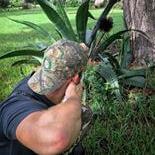Low-Visibility Lighting for Target Practice
This has always been something I have tried to do, unless I just really had the itch to get out and shoot. A majority of the time, an individual will take his/her shot during hours of limited (or low) light. Why not practice during those same times? A bright yellow and red target block perfectly measured out during peak light is a little different than a living creature with the ability to move and somewhat blend to its natural surroundings during hours of limited visibility. Get some coffee in you, wake up and get to shootin’. Don’t forget to send a few towards a target after work, before the sun goes down.
Stop, Wait a Minute
Chances are you have run across a situation where you pulled, were ready to shoot and the situation changed. Allowing a situation to develop, grasping the full picture and putting it all together (sometimes within a minute or so) can mean everything to obtaining a successful harvest. One method I like to use is holding my bow at full draw for at least a minute and then giving myself a few seconds to take up a good sight picture and make a shot. This will both prepare you for a potential hold-out as well as simulate the body’s natural shake (of varying extents) when the time of taking a deer draws near.
Draw n’ Shoot (Quick Shot)
The opposite of the above-mentioned, training to shoot quickly simulates those situations that are quick to arise. Maybe a big buck swiftly moves into your area from a blind spot and you know you only have so long to make a shot. If you haven’t practiced putting everything together and delivering an arrow downrange with a quickness, there is a high likelihood that the only thing happening quickly will be your improper announcement as to your whereabouts. It’s as easy as it sounds. Preferably, you’d practice this in whatever “get-up” you’ll be hunting in but just getting everything together to make a quick shot will generally suffice.
Change Your Positions
You will more than likely not be in the perfect position (or the one you practice most) when an opportunity arises. Attempting to get into your favorite position when you have an opportunity could very well jeopardize a shot. Practice a variety of positions: sitting, standing, kneeling, sitting. Tailor what you practice to the positions you could find yourself in. If you ground hunt, what you practice may not be the same as your buddy in the stand. Also, try mixing in some foliage to shoot around; clear is ideal but ideal isn’t always what’s available.

Switch up the Angles
Almost everyone I know practices in the standing position, 20-40 yards straight back from a target block. Shooting is shooting, right? Except for it’s not, especially if you’re in a stand. Varying the angles at which you shoot during practice will only further prepare you to be confident with taking a variety of shots in the field. Start ripping down some barriers and truly hone in on the realistic shots you’ll expect yourself to make in order to harvest. “You can’t expect what you don’t inspect.” Meaning, how do you expect yourself to make a shot when it becomes available if you have never once practiced it? Don’t be the guy (or gal) that says, “if only I would have…”
Broaden Your Horizons
An often neglected part of most routines is shooting your broadheads prior to the season starting. Each individual minute detail is important if you want to be dragging something out of the field and towards the freezer. Flight paths change per arrow. Narrow down exactly what you are going to be taking to the field with you and practice tightening your grouping with those. You don't want to get out there and put your trust in equipment you haven't tested yourself.

Why so Close?
20-40 yards is the typical distance(s) individuals shoot at while practicing. There’s nothing wrong with that; however, if you’re comfortable there why not move on? By show of hands, how many have had opportunities to take something down but it was outside of your comfort zone? Hunting (especially with bow) is imperfect science and art. All deer are different and all situations different. Rarely will that big guy or stout gal line up perfectly at a range that ends in ‘0.’ Change things up and show those deer you are ready. Be advised, even small mistakes at greater distances become larger mistakes (ask LSU), so dial-in those groups. Don’t let this scare you, I know you can do it. GEAUX TIGERS!

Yo Buddy Booner Buck Target
Charlie Anable – LABH Contributor
news@louisianabowhunter.com

